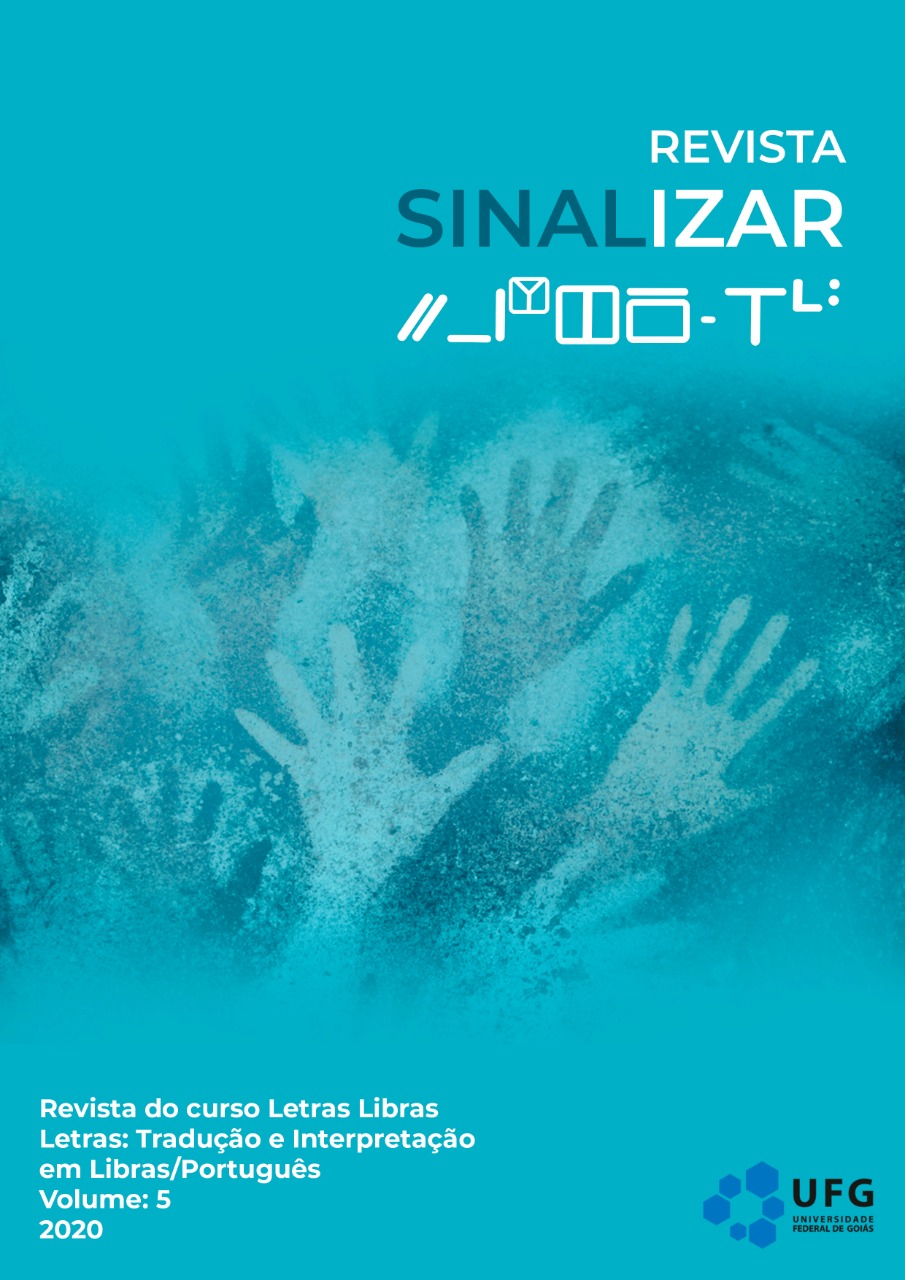Cognitive development in deaf people and acquisition of Sign Language
DOI:
https://doi.org/10.5216/rs.v5.65749Keywords:
Deaf, Language, CognitionAbstract
This study aims to understand how the process of linguistic development of the deaf occurs in Vygotsky's perspective on the interconnection between cognition and contact with language and in the view of Chomsky, who defends the biological faculty of language. In order to do this, a bibliographic research was carried out with the intention to learn more about neural circuits, cognitive ability, innate disposition for language, and the influence of social interaction in deaf people. As studies show, deaf people are not unable to learn. They only have different possibilities and a need for adequate exposure to their mother tongue in order to better develop their linguistic potential.
Downloads
References
CAPLAN, David. Language related córtex in deaf individuals: functional specialization for language or perceptual plasticity. Proceedings of the National Academy of Sciences of the States of America, v. 97, n. 25, 2000, p. 13476-13477. Disponível em: https://www.pnas.org/content/97/25/13476. Acesso em: 20 jun. 2020.
CHOMSKY, Noam. Novas perspectivas linguísticas. Petrópolis: Vozes, 1971.
______. Estruturas sintáticas. Trad. Gabriel de Ávila Othero e Sérgio de Moura Menuzzi. Petrópolis: Vozes, 2015.
EMMOREY, Karen. Processing a dynamics visual-spatial language: psycholinguistic studies of American sign language. Journal of Psycholinguistic Research, v. 22, issue 2, p. 153-187, 1993. Disponível em: https://link.springer.com/article/10.1007/BF01067829. Acesso em: 17 jun. 2020.
FONSECA, Rochele Paz; PARENTE, Maria Alice de Mattos Pimenta. Relação entre linguagem e hemisfério direito. In: ORTIZ, Karin Zazo (Org). Distúrbios neurológicos adquiridos: linguagem e cognição. Barueri: Manole, 2005. p. 136-56
FONSECA, Vitor da. Dislexia, cognição e aprendizagem: uma abordagem neuropsicológica das dificuldades de aprendizagem da leitura. Revista Psicopedagogia, São Paulo, v. 26, n. 81, p. 339-356, 2009. Disponível em: http://pepsic.bvsalud.org/scielo.php?script=sci_arttext&pid=S0103-84862009000300002. Acesso em: 16 jun. 2020.
GOLDFELD, Marcia. A criança surda: linguagem e cognição numa perspectiva sócio-interacionista. 7. ed. São Paulo: Plexus, 2002.
INSTITUTO BRASILEIRO DE GEOGRAFIA E ESTATÍSTICA. Censo Demográfico 2010. Características gerais da população, religião e pessoas com deficiência. Rio de Janeiro: IBGE, 2010. Disponível em: https://biblioteca.ibge.gov.br/visualizacao/periodicos/94/cd_2010_religiao_deficiencia.pdf. Acesso em: 16 jun. 2020.
JOANETTE, Yves et al. Fundamentos neurobiológicos da recuperação das afasias: do neurobiológico ao psicossocial. In: NITRINI, Ricardo; CARAMELLI, Paulo; MANSUR, Letícia Lessa (Org.). Neuropsicologia: das bases anatômicas à reabilitação. São Paulo: Faculdade de Medicina da USP, 1996. p. 203-14
JOHNSON, Jacqueline S.; NEWPORT, Elissa Lee. Critical period effects in second language learning: the influence of maturational state on the acquisition of English as a second language. Cognitive Psychology, v. 21, issue 1, p. 60-99, 1989. Disponível em: https://www.sciencedirect.com/science/article/abs/pii/0010028589900030?via%3Dihub. Acesso em: 16 jun. 2020.
KANDEL, Eric R.; SCHWARTZ, James H.; JESSEL, Thomas M. Fundamentos da neurociência e do comportamento. Rio de Janeiro: Guanabara Koogan, 1997.
LABORIT, Emmanuelle. O voo da gaivota. São Paulo: Best Seller, 1994.
MAYBERRY, Rachel I.; EICHEN, Ellen B. The lost-lasting advantage of learning sign language in childhood: another look at the critical period for language acquisition. Journal of Memory and Language, v. 30, issue 4, p. 486-512, 1991. Disponível em: https://www.sciencedirect.com/science/article/abs/pii/0749596X9190018F. Acesso em: 17 jun. 2020.
MENDONÇA, Lúcia Iracema Zanotto de. Contribuições da neurologia no estudo da linguagem. In: ORTIZ, Karin Zazo (Org.). Distúrbios neurológicos adquiridos: linguagem e cognição. Barueri: Manole, 2005. p. 1-33
NEWPORT, Elissa Lee. Maturacional constraints on language learning. Cognitive Science, v. 14, n. 1, p. 11-28, 1990. Disponível em: https://onlinelibrary.wiley.com/toc/15516709/1990/14/1. Acesso em: 17 jun. 2020.
OBLER, Loraine K.; GJERLOW, Kris. Language and brain. Cambridge: Cambridge University Press, 2000.
PETITTO, Laura Ann et al. Speech-like cerebral activity in profoundly deaf people processing signed languages: Implications for the neural basis of human language. Proceedings of the National Academy of Sciences, v. 97, n. 25, p. 13961-13966, 2000. Disponível em: https://www.pnas.org/content/97/25/13961. Acesso em: 20 jun. 2020.
PIAGET, Jean. A linguagem e o pensamento da criança. Trad. Manuel Campos. São Paulo: Martins Fontes, 1986.
PIZZIO, Aline Lemos; QUADROS, Ronice Müller de. Aquisição da língua de sinais. Florianópolis: Universidade Federal de Santa Catarina, 2011. (Apostila). Disponível em: http://www.libras.ufsc.br/colecaoLetrasLibras/eixoFormacaoEspecifica/aquisicaoDeLinguaDeSinais/assets/748/Texto_Base_Aquisi_o_de_l_nguas_de_sinais_.pdf. Acesso em: 6 fev. 2020.
QUADROS, Ronice Muller de. Educação de surdos: aquisição da linguagem. Porto Alegre: Artmed, 1997.
SANTANA, Ana Paula. Surdez e linguagem: aspectos e implicações neurolinguísticas. São Paulo: Plexus, 2007.
SKINNER, Burrhus Frederic. O comportamento verbal. Trad. Maria da Penha Villalobos. São Paulo: Cultrix/EDUSP, 1978.
VYGOTSKY, Lev Semyonovich. Fundamentos de defectologia. Havana: Pueblo Y Educación, 1989. Obras completas, tomo V.
______. Pensamento e linguagem. Trad. Jefferson L. Camargo. São Paulo: Martins Fontes, 2000.
______. Aprendizagem e desenvolvimento intelectual na idade escolar. In: VYGOTSKY, Lev Semyonovich; LÚRIA, Alexander Romanovich; LEONTIEV, Alex Nikolaevich. Linguagem, desenvolvimento e aprendizagem. 12. ed. Trad. Maria da Pena Villalobos. São Paulo: Ícone, 2012.
Downloads
Published
How to Cite
Issue
Section
License
Copyright

This work is licensed under a Creative Commons Attribution-NonCommercial-NoDerivatives 4.0 International License.
Autores que publicam nesta revista concordam com os seguintes termos:
Autores mantém os direitos autorais e concedem à revista o direito de primeira publicação, com o trabalho simultaneamente licenciado sob a Creative Commons Attribution License que permitindo o compartilhamento do trabalho com reconhecimento da autoria do trabalho e publicação inicial nesta revista.
Autores têm autorização para assumir contratos adicionais separadamente, para distribuição não-exclusiva da versão do trabalho publicada nesta revista (ex.: publicar em repositório institucional ou como capítulo de livro), com reconhecimento de autoria e publicação inicial nesta revista.







